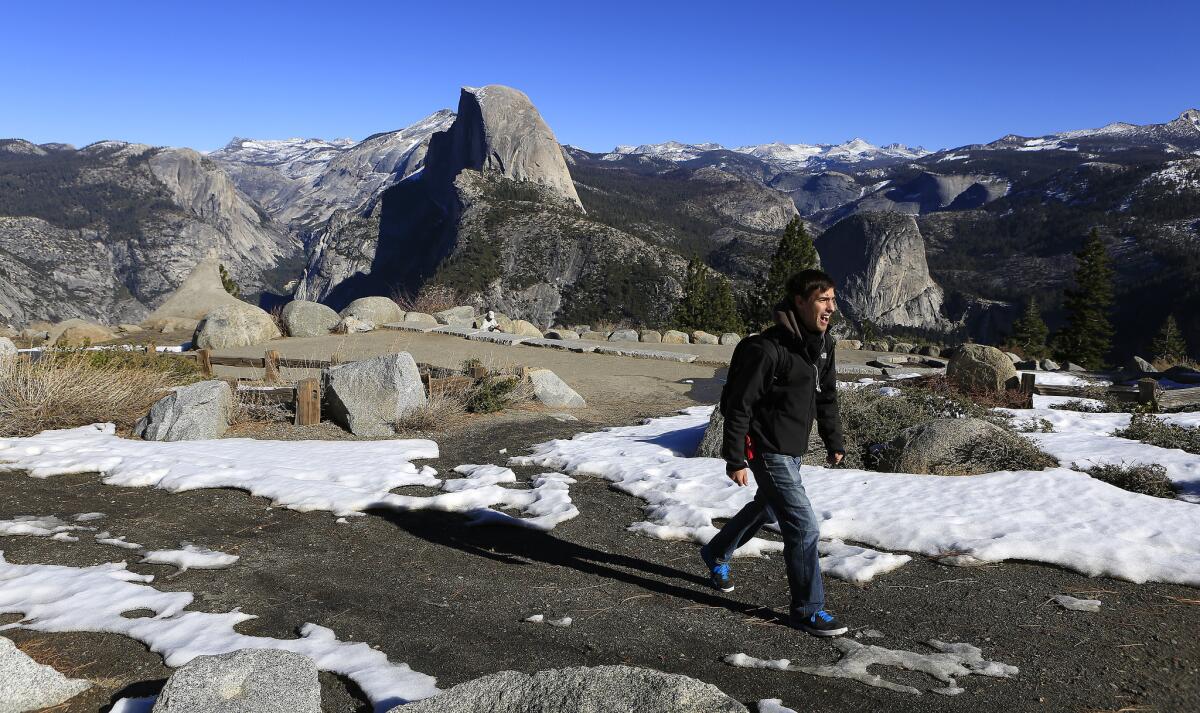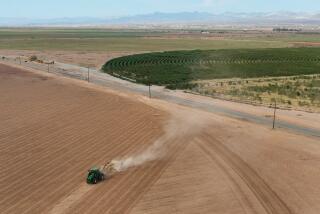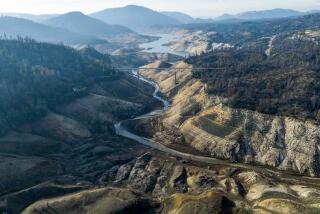Hopes rise for a strong El Niño to ease California drought

Darrell Carlis of Fresno hikes past patchy snow at Glacier Point in
In Texas, Oklahoma and Mexico, destructive storms flooded communities and unleashed a tornado, leaving more than two dozen dead.
Across Southern California, this month has been decidedly cooler and wetter. San Diego had its wettest May in 94 years, and Los Angeles saw nearly four times its average rainfall. This month, the San Diego Padres were forced to call a rain delay — only the fifth time that has happened in Petco Park’s 11-year history. Even the Mojave Desert is running as much as 5 degrees cooler than normal.
To some scientists, these are signs that the elusive, unpredictable El Niño weather phenomenon is gaining strength — and offering a glimmer of hope after more than three years of extreme drought.
El Niños have been responsible for two of California’s wettest and most destructive rainy seasons: the winters of 1982-83 and 1997-98.
Now, experts say, a potentially powerful El Niño this winter could be the beginning of the end of the drought.
This month’s weather suggests how El Niño’s building strength is already affecting the United States. It’s giving weather scientists reason to be cautiously optimistic that it has the stamina to see it through California’s rainy season, which typically begins in October and ends in April.
“Can one big year ease the drought conditions? Yes, it can,” said Michael Anderson, state climatologist with the California Department of Water Resources. “It can definitely replenish the surface storage and can have some benefit to starting to replenish some of the groundwater.”
In December, California water officials said that it would take 75 inches of precipitation in the northern Sierra Nevada — a major source of water for the state — to end the drought and bring reservoir storage and runoff back to normal levels.
So far, the traditional rain season has been a bust — only 34.9 inches have fallen, below the average of 50 inches.
But the infamous winter of 1982-83 dropped 88.5 inches of precipitation into the northern Sierra Nevada, the wettest season on record, according to the Department of Water Resources.
That year, El Niño’s influence was also seen in the Rocky Mountains, another source of California water. So much runoff flowed down the Colorado River that Glen Canyon Dam almost burst in 1983. The situation was so precarious that chunks of rock and pieces of concrete poured out of the dam’s spillways.
“To get the wettest winters possible, you almost need an El Niño,” said Kelly Redmond, regional climatologist at the Western Regional Climate Center. “The biggest winters, almost without exception, are El Niño winters.”
The problem is there’s no reason to believe such a year wouldn’t be followed by another arid one.
“This drought is not a one shot deal [in which] when it goes away, everything goes back to normal,” said Bill Patzert, a climatologist for the Jet Propulsion Laboratory in La Cañada Flintridge. “You’re living in an even warmer world” and a world of declining snowpack, all of which will test water supplies for years. “The warmer it is during the day, the more evaporation you get. So to maintain your landscaping, it takes more water.”
“It’s the continuation of the long dry years that are the real problem, as we’re seeing now,” said Jeanine Jones, deputy drought manager for the Department of Water Resources.
El Niño is the warming of Pacific Ocean waters along the equator, from Peru to the International Date Line, that causes changes to the atmosphere and can influence weather globally.
Last year, scientists thought El Niño was forming in the Pacific, only to watch it fade out.
There’s reason to believe this coming winter could be different, as El Niño appears to enforce its will elsewhere in the country — offering a possible preview of what California could see.
Record storms in Texas and Oklahoma over the last few weeks have dramatically ended a 41/2-year drought, said Oklahoma state climatologist Gary McManus, erasing “all short-term and long-term impacts, from agriculture all the way down to deeper soil moisture levels and those reservoirs that were going dry.”
Whether California gets another epic El Niño by winter is “the $64,000 question,” said Dan Cayan, climate researcher for the Scripps Institution of Oceanography and the U.S. Geological Survey. “There are a number of models, some of which point strongly in that direction.”
Though El Niños are often seen as synonymous with rain, in fact it is only the strong ones that are reliable forecasters for above-average precipitation. Some El Niño years gave Southern California extremely dry weather. The driest year in L.A.’s recorded history, from July 2006 to June 2007, happened during a weak El Niño.
Conversely, some very wet years have happened during non-El Niño years.
But even if big rains come, experts warn that it would be foolish to ease up on the water conservation measures California has taken.
Dry years, after all, have been the rule, not the exception for California and the rest of the Southwest for the better part of 15 years. Because of warmer temperatures, the intensity of future droughts is expected to worsen.
“We most likely will be having an increasing population,” said Jones of the Department of Water Resources. “We expect a future with climate change. We expect greater risk of drought, so we should be preparing for that.”
More to Read
Sign up for Essential California
The most important California stories and recommendations in your inbox every morning.
You may occasionally receive promotional content from the Los Angeles Times.












